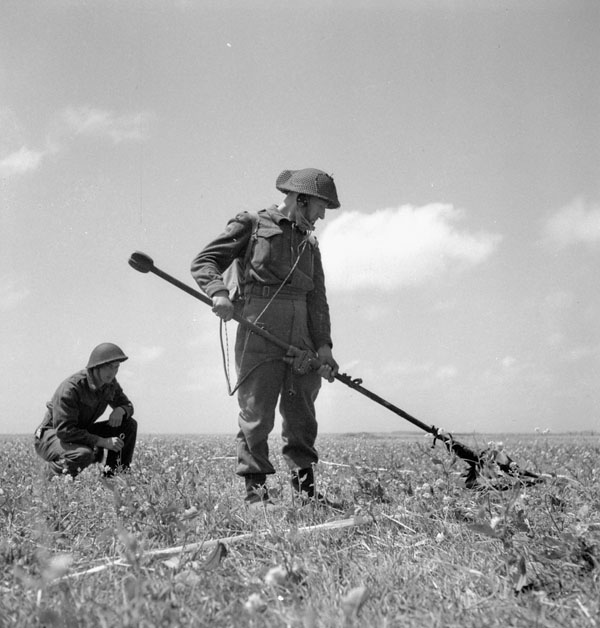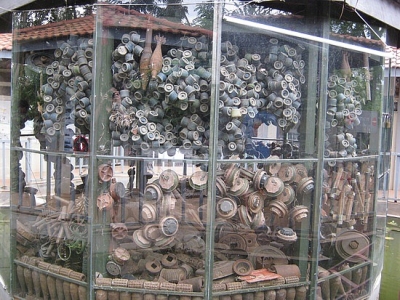Anti-Personnel Mines around the World
Anti-personnel mines are devices designed to explode in proximity or on contact with a human being. They are inexpensive and have been widely used since the Second World War in various conflicts, such as the Vietnam War, the Korean War and the Persian Gulf War. Also, during the Cold War, many countries laid mines along their borders.
Left in place, these landmines continue to claim civilian victims even after armies have withdrawn. For example, Cambodia has more landmines and explosive remnants of war buried in its soil than any other country on Earth. After the end of many years of war, the country found itself littered with unexploded ordnance. An estimated six million landmines lie buried in Cambodia, but they cannot be readily located, for lack of reliable records (the soldiers who laid these mines usually made no records of their location). Cambodia has one of the highest rates of physical disability of any country in the world. Since 1979, mines have killed or injured 65,000 Cambodians, half of them children.
The International Campaign to Ban Landmines
In October 1992, six non-governmental organizations ‒ Handicap International, Medico International, Human Rights Watch, the Mines Advisory Group, the Vietnam Veterans of America Foundation and Physicians for Human Rights ‒ launched an international campaign to ban anti-personnel mines. In the course of 1993, the International Committee of the Red Cross and various non-governmental organizations held several conferences and meetings to determine the best ways of helping the victims of landmines and to develop a strategy for an international campaign that would lead to the banning of anti-personnel mines.
In December 1993, the United Nations General Assembly adopted a resolution calling for the renewal of the 1980 Convention on Prohibitions or Restrictions on the Use of Certain Conventional Weapons, along with another resolution calling for a moratorium on the exporting of anti-personnel mines. Some countries, such as Italy, the United Kingdom, Belgium and Ireland, campaigned for a ban on anti-personnel mines, while others, such as Spain, Argentina, Germany, Israel, the Czech Republic and Russia, announced moratoriums on their export. South Africa prohibited the export of such mines, while Cambodia banned their import and installation.
In March 1995, Belgium became the first country to pass legislation on the use, production, acquisition, sale and transfer of anti-personnel mines. Several other European countries then followed suit and destroyed their stockpiles of mines. Like France and Switzerland, Canada announced, in January 1996, a moratorium on the use, production, trade and export of anti-personnel mines.
At the international level, discussions continued, but it quickly became clear that there was no consensus on the steps that should be taken to fight anti-personnel mines. At the Vienna Conference of September 1995, the countries failed to agree to renew the 1980 Convention, and a few months later, in May 1996, history repeated itself at the Geneva Conference organized by the United Nations. Although Protocol II to the 1980 Convention (the Protocol on Prohibitions or Restrictions on the Use of Mines, Booby-Traps and Other Devices) was amended at this meeting and introduced a number of changes, it was far from a total ban on anti-personnel mines. And yet some 40 countries at Geneva, including Canada, favoured such a ban. These countries denounced the fact that 57 other countries were calling for a mere limitation on anti-personnel mines. As the conference ended, the Canadian delegation realized that the campaign for an international ban was in danger of petering out, decided to assume its leadership, and announced that another conference should be held before the end of the year. This conference would bring together those countries that favoured a ban, with the goal of developing a strategy for committing the international community to banning the use, production and sale of anti-personnel mines.
The Ottawa Process
This conference was held in Ottawa from 3 to 5 October 1996. Officially entitled the “International Strategy Conference: Towards a Global Ban on Anti-Personnel Mines” but usually referred to as “the 1996 Conference” or “the first Ottawa Conference,” this meeting was attended by 50 participating countries, 24 observers and numerous international organizations. Though no official document emerged from this conference, it did establish the general framework for the “Ottawa Process” that ultimately led to a legally binding international agreement to ban anti-personnel mines. At the closing session of this conference, Lloyd Axworthy, Canada’s minister of Foreign Affairs, appealed to all countries to return to Ottawa before the end of 1997 to sign such an agreement. This Canadian initiative received the support of the President of the International Committee of the Red Cross and the Secretary General of the United Nations.
Over the following weeks, a diplomatic ballet ensued, resulting in a meeting of representatives of 111 countries in Vienna in February 1997 to discuss a first draft of a treaty that had been prepared by the Austrian government. In June 1997, at the International Conference for a Global Ban on Anti-Personnel Mines, in Brussels, 97 of the 154 participating countries signed the “Brussels Declaration,” which stressed the importance of including the following elements in a treaty to ban anti-personnel mines : 1) a comprehensive ban on the use, stockpiling, production and transfer of anti-personnel mines; 2) the destruction of all stockpiled and cleared anti-personnel mines; and 3) international cooperation and assistance in the area of mine clearance in affected countries. The final text of the treaty was adopted in Oslo, Norway on 18 September 1997 at the end of a three-week conference and was opened for signing at the Second Ottawa Conference on 3 and 4 December of that year.
Impacts and Importance of the Ottawa Treaty
The Ottawa Process thus ended in the same city where it had begun 14 months earlier. In all, 122 countries signed the Convention on the Prohibition of the Use, Stockpiling, Production and Transfer of Anti-Personnel Mines and on their Destruction, which came into force on 1 March 1999. As of 2017, 20 years after its adoption, 162 countries have ratified the Ottawa Treaty, and 30 countries that were once heavily mined are now considered free of anti-personnel mines. But a number of countries still have extensive mine-clearing to do, while others are behind schedule in their mine-clearing efforts. As of 2015, it was estimated that nearly 18 deaths or injuries related to explosion of mines or explosive remnants of war occurred in the world every day and that mine-clearing operations were still needed in over 60 countries. Moreover, as of 2016, more than 35 countries still had not signed the Ottawa Treaty, including some of the world’s largest manufacturers of mines, such as the United States, China and Russia.
The International Campaign to Ban Landmines (ICBL) monitors the progress of mine-clearing efforts worldwide. Mine-clearing operations are carried out both by non-governmental organizations, such as the Mines Advisory Group and the HALO Trust, and by businesses, such as BACTEC, a group of companies that specialize in landmine and battle area clearance. Canadians have also established the Canadian Landmine Foundation, which, from 1999 to 2008, carried out 91 projects in 13 countries, trained a number of mine-detection dogs and raised $4 million in funding. In 2014, the countries that were signatories to the Ottawa Treaty set themselves the target of eradicating landmines completely by 2025.
In conclusion, the campaign conducted by various non-governmental organizations to ban anti-personnel mines is a fine example not only of international mobilization around a humanitarian issue, but also of Canadian leadership on the world stage during the post-Cold War era. The Ottawa Process marked a change in the role that non-governmental organizations play in diplomatic discussions. Whereas these organizations had traditionally played only an advisory role, in the Ottawa Process they became active participants in the conferences and made their voices heard at the bargaining table.

 Share on Facebook
Share on Facebook Share on X
Share on X Share by Email
Share by Email Share on Google Classroom
Share on Google Classroom





